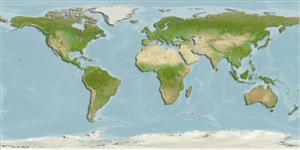>
Pleuronectiformes (Flatfishes) >
Achiropsettidae (Southern flounders)
Etymology: Pseudomancopsetta: Greek, pseudes = false + Latin, mancus = incomplete + Greek, psetta = grouper (Ref. 45335); andriashevi: Named for A.P. Andriyashev (Ref. 5105).
Environment: milieu / climate zone / depth range / distribution range
Ökologie
seewasser demersal; tiefenbereich 200 - 365 m (Ref. 5192). Temperate; 45°S - 47°S
Southeast Pacific: south coast of Chile. Southern Ocean: Crozet Islands and Prince Edward Island.
Size / Gewicht / Alter
Maturity: Lm ? range ? - ? cm
Max length : 14.2 cm SL Männchen/unbestimmt; (Ref. 119562)
Kurzbeschreibung
Bestimmungsschlüssel | Morphologie | Morphometrie
Rückenflossenweichstrahlen (insgesamt) : 86; Afterflossenweichstrahlen: 70. Mouth small. Eyes closely placed. Anal fin beginning under the last rays of the left pelvic fin. Gill rakers present on both the outer and inner sides of the first gill arch; the second raker from below on the outer side of the upper part of the first gill arch shorter than others (Ref. 5105).
Maximum depth reported in Ref. 5105 is 240m.
Life cycle and mating behavior
Maturities | Fortpflanzung | Spawnings | Egg(s) | Fecundities | Larven
Heemstra, P.C., 1990. Achiropsettidae. p. 408-413. In O. Gon and P.C. Heemstra (eds.) Fishes of the Southern Ocean. J.L.B. Smith Institute of Ichthyology, Grahamstown, South Africa. (Ref. 5000)
IUCN Rote Liste Status (Ref. 130435)
Bedrohung für Menschen
Harmless
Nutzung durch Menschen
Tools
Zusatzinformationen
Download XML
Internet Quellen
Estimates based on models
Preferred temperature (Ref.
123201): 2.2 - 3.2, mean 2.4 °C (based on 14 cells).
Phylogenetic diversity index (Ref.
82804): PD
50 = 1.0625 [Uniqueness, from 0.5 = low to 2.0 = high].
Bayesian length-weight: a=0.01995 (0.00906 - 0.04395), b=3.01 (2.83 - 3.19), in cm total length, based on all LWR estimates for this body shape (Ref.
93245).
Trophic level (Ref.
69278): 3.4 ±0.5 se; based on size and trophs of closest relatives
Fishing Vulnerability (Ref.
59153): Low vulnerability (10 of 100).
Nutrients (Ref.
124155): Calcium = 83.6 [32.6, 145.0] mg/100g; Iron = 0.389 [0.186, 0.754] mg/100g; Protein = 17.7 [15.3, 20.4] %; Omega3 = 0.474 [0.226, 1.024] g/100g; Selenium = 12.1 [5.5, 26.7] μg/100g; VitaminA = 22.1 [4.8, 100.1] μg/100g; Zinc = 0.634 [0.411, 0.942] mg/100g (wet weight);
